-
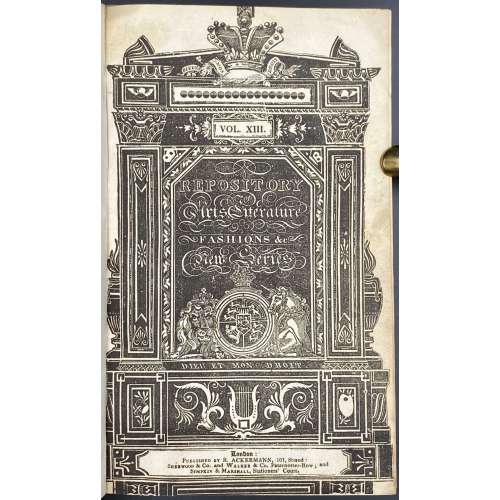 Pagination: [2] – letterpress title / blank, t.p. with contents / to readers, [1] 2-376 + 7 b/w and 16 coloured plates (total 23); this differs to Abbey’s description of 372 pages + 4 pages index, and 41 plates (lacking 18 plates). In No 73 lacking 3 plates: Quadrant Regent st., Morning dress and Full dress. In No 74 lacking 5 plates: Charles str., Brienz, head dresses, full dress, and muslin patterns. In No 75 lacking 5 plates: 4 with bank notes and Castle of Rinkenberg. In No 76 lacking 1 plate: Cavern St. Beat. In No 77 lacking 2 plates: Wetzar and Lake Thun. In No 78 lacking 2 plates: Crescent at Portland Place and Environs of Thun. Collation: 4to; letterpress title, [A]1 B-Z4 Aa-Zz4 3A-3C4 3D2. Binding: 23.5 x 15.5 cm; double fillet blind-ruled half-calf over pebbled cloth boards, raised bands ruled blind, crimson label with gilt lettering to spine. References: Martin Hardie (1906), p.310 [LIB-2623.2021]; R. V. Tooley (1935), p. 26 [LIB-2641.2021]; J. R. Abbey (1953), Cat. № 212, p. 174 [LIB-2622.2021].
Pagination: [2] – letterpress title / blank, t.p. with contents / to readers, [1] 2-376 + 7 b/w and 16 coloured plates (total 23); this differs to Abbey’s description of 372 pages + 4 pages index, and 41 plates (lacking 18 plates). In No 73 lacking 3 plates: Quadrant Regent st., Morning dress and Full dress. In No 74 lacking 5 plates: Charles str., Brienz, head dresses, full dress, and muslin patterns. In No 75 lacking 5 plates: 4 with bank notes and Castle of Rinkenberg. In No 76 lacking 1 plate: Cavern St. Beat. In No 77 lacking 2 plates: Wetzar and Lake Thun. In No 78 lacking 2 plates: Crescent at Portland Place and Environs of Thun. Collation: 4to; letterpress title, [A]1 B-Z4 Aa-Zz4 3A-3C4 3D2. Binding: 23.5 x 15.5 cm; double fillet blind-ruled half-calf over pebbled cloth boards, raised bands ruled blind, crimson label with gilt lettering to spine. References: Martin Hardie (1906), p.310 [LIB-2623.2021]; R. V. Tooley (1935), p. 26 [LIB-2641.2021]; J. R. Abbey (1953), Cat. № 212, p. 174 [LIB-2622.2021]. -
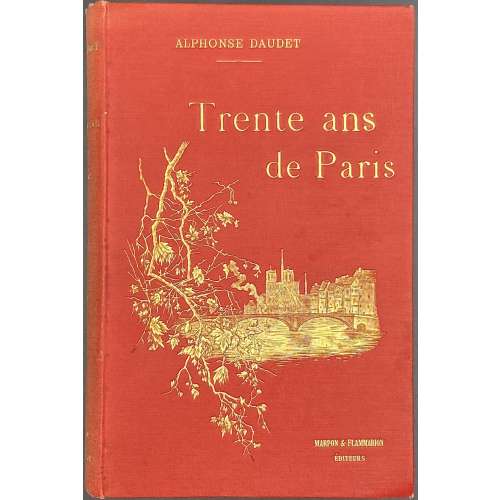 Pictorial title (coloured): Collection Artistique Guillaume et Cie |—| ALPHONSE DAUDET | Trente ans | de Paris | PARIS | C. MARPON ET E. FLAMMARION | 26, RUE RACINE, 26 | 1888 || Title page: Collection Artistique Guillaume et Cie |—| ALPHONSE DAUDET | Trente ans de Paris | À TRAVERS MA VIE ET MES LIVRES | Illustré | PAR BIELER, MONTÉGUT, MYRBACH, PICARD ET ROSSI | Gravure de Guillaume Frères et Cie | PARIS | C. MARPON ET E. FLAMMARION | 26, RUE RACINE, 26 | 1888 | Tous droits réservés. || Pagination: [12] [1] 2-344 [6], total 362 pp., in-text illustration, head- and tailpieces, photomechanical reproductions. Collation: 12mo; π6, 1-2812 +1; total 181 leaves. Binding: 19 x 12.5 cm; red cloth, gilt lettering to spine, gilt lettering and vignette to front board and gilt device to back board; bookplate to front pastedown: Ex Libris Dr. Vodoz = Egg; Gift inscription to flyleaf in German, dated 30/12/87. Contributors: Alphonse Daudet (French, 1840 – 1897) – author. Ernest Biéler (Swiss, 1863 – 1948) – artist. Louis Montégut (French, 1855 – 1906) – artist. Felician Myrbach (Austrian, 1853 – 1940) – artist. Georges Picard (French, 1857 – 1943) – artist. Luigi Rossi (Swiss, 1853 – 1923) – artist. Ernest Flammarion (French, 1846 – 1936) – publisher. Charles Marpon (French, 1838 – 1890) – publisher. Alexis Lahure (French, 1849 – 1928) – printer. Guillaume Frères et Cie – engravers.
Pictorial title (coloured): Collection Artistique Guillaume et Cie |—| ALPHONSE DAUDET | Trente ans | de Paris | PARIS | C. MARPON ET E. FLAMMARION | 26, RUE RACINE, 26 | 1888 || Title page: Collection Artistique Guillaume et Cie |—| ALPHONSE DAUDET | Trente ans de Paris | À TRAVERS MA VIE ET MES LIVRES | Illustré | PAR BIELER, MONTÉGUT, MYRBACH, PICARD ET ROSSI | Gravure de Guillaume Frères et Cie | PARIS | C. MARPON ET E. FLAMMARION | 26, RUE RACINE, 26 | 1888 | Tous droits réservés. || Pagination: [12] [1] 2-344 [6], total 362 pp., in-text illustration, head- and tailpieces, photomechanical reproductions. Collation: 12mo; π6, 1-2812 +1; total 181 leaves. Binding: 19 x 12.5 cm; red cloth, gilt lettering to spine, gilt lettering and vignette to front board and gilt device to back board; bookplate to front pastedown: Ex Libris Dr. Vodoz = Egg; Gift inscription to flyleaf in German, dated 30/12/87. Contributors: Alphonse Daudet (French, 1840 – 1897) – author. Ernest Biéler (Swiss, 1863 – 1948) – artist. Louis Montégut (French, 1855 – 1906) – artist. Felician Myrbach (Austrian, 1853 – 1940) – artist. Georges Picard (French, 1857 – 1943) – artist. Luigi Rossi (Swiss, 1853 – 1923) – artist. Ernest Flammarion (French, 1846 – 1936) – publisher. Charles Marpon (French, 1838 – 1890) – publisher. Alexis Lahure (French, 1849 – 1928) – printer. Guillaume Frères et Cie – engravers. -
 Hand-coloured etching by an anonymous British artist, printed on May 26, 1829, in London. Description by British Museum (1868,0808.8988): "O'Connell, in wig and gown, walks to the left from the massive door of a small stone building, stooping, and holding his handkerchief to his right eye. He wails: 'O, my poor Seat! my poor Seat! my poor Seat! I'd have given any thing for a seat.' In the doorway (right) stands Peel, saying with wary blandness: 'What good can weeping do you Dan.—I'm sure I did as much as I could!!' Above the large knocker on the plank door is 'Knock & Ring'. There is a projecting bell, above a placard: 'NB. Jews or Proselytes desirous of Obtaining Seats in the House may Knock and Ring at this Door.' One corner of "the House", a small stone shed, is depicted. O'Connell is walking towards a strip of water, across which is a mountain, with a board pointing 'To — Clare'. Comment by BM: "Catholic Emancipation raised high hopes among Jews; the first Bill, after a petition from Jews in Liverpool, was introduced 15 Apr. 1830, but Jewish Emancipation did not become law till 1858." Inscription under the frame with title, "A. Sharpshooter fec", text within image and publication line: "Pub. by G. Humphrey, 24 St. James's Street May 26 1829". Size: 37.5 x 26 cm.
Hand-coloured etching by an anonymous British artist, printed on May 26, 1829, in London. Description by British Museum (1868,0808.8988): "O'Connell, in wig and gown, walks to the left from the massive door of a small stone building, stooping, and holding his handkerchief to his right eye. He wails: 'O, my poor Seat! my poor Seat! my poor Seat! I'd have given any thing for a seat.' In the doorway (right) stands Peel, saying with wary blandness: 'What good can weeping do you Dan.—I'm sure I did as much as I could!!' Above the large knocker on the plank door is 'Knock & Ring'. There is a projecting bell, above a placard: 'NB. Jews or Proselytes desirous of Obtaining Seats in the House may Knock and Ring at this Door.' One corner of "the House", a small stone shed, is depicted. O'Connell is walking towards a strip of water, across which is a mountain, with a board pointing 'To — Clare'. Comment by BM: "Catholic Emancipation raised high hopes among Jews; the first Bill, after a petition from Jews in Liverpool, was introduced 15 Apr. 1830, but Jewish Emancipation did not become law till 1858." Inscription under the frame with title, "A. Sharpshooter fec", text within image and publication line: "Pub. by G. Humphrey, 24 St. James's Street May 26 1829". Size: 37.5 x 26 cm. -
 Title: Third lunar month [弥生] (Yayoi no zu); Series: Fashionable Twelve Months (Imayo juni-kagetsu). Another version of translation: Modern Beauties of Twelve Months. Artist: Utagawa Toyokuni I [歌川豊国] (1769–1825). Pubisher: Ibaya Senzaburō [伊場屋仙三郎] (Japanese, 1815 – 1869), seal: Dansendō [伊場仙]. Signed: Toyokuni ga and sealed with toshidama. Date-kiwame seal: Ushi (ox), Bunsei 5 (1822). Size: double-sheet uncut fan print ( aiban uchiwa-e), 219 x 295 mm.
Title: Third lunar month [弥生] (Yayoi no zu); Series: Fashionable Twelve Months (Imayo juni-kagetsu). Another version of translation: Modern Beauties of Twelve Months. Artist: Utagawa Toyokuni I [歌川豊国] (1769–1825). Pubisher: Ibaya Senzaburō [伊場屋仙三郎] (Japanese, 1815 – 1869), seal: Dansendō [伊場仙]. Signed: Toyokuni ga and sealed with toshidama. Date-kiwame seal: Ushi (ox), Bunsei 5 (1822). Size: double-sheet uncut fan print ( aiban uchiwa-e), 219 x 295 mm.

-
 Artist: Utagawa Kunisada [歌川 国貞] a.k.a. Utagawa Toyokuni III [三代歌川豊国] (Japanese, 1786 – 1865). Signed: Toyokuni ga [豊国 画] in a red toshidama cartouche. Publisher: Ibaya Senzaburō [伊場屋仙三郎] (Japanese, c. 1815 – 1869). Block carver: Yokokawa Takejirō [横川竹二郎] (Japanese, fl. 1845 – 1863); seal Hori Take [彫竹]. Double nanushi censor seals: Mera & Murata (1847-50). Title: Cool Breeze on Tenpōzan Hill in Naniwa [浪花天保山の涼] (Naniwa Tenpōzan no ryō). An uncut fan print (uchiwa-e), depicting a gentleman (most probably kabuki actor Nakamura Utaemon IV) holding a pipe with the view of Tenpōzan Hill [天保山] in Naniwa (Osaka) in the background. A distinctive structure on the left is the Sumiyoshi Lantern [住吉高灯篭] (Sumiyoshi takadōrō), which was destroyed by a typhoon in 1950. The character 翫 – moteasobu – on the gentleman’s robe means "take pleasure, play an instrument". Nakamura Utaemon IV [中村歌右衛門] (Japanese, 1796 – 1852); other names: Nakamura Shikan II, Nakamura Tsurusuke I, Nakamura Tōtarō. The character is visually similar to a gentleman drinking tea on a veranda under the shining moon from the series ‘Moon, Sun, Stars’ [月日星] (Getsu hi hoshi), see SVJP-0211-1.2016: The Moon.
Artist: Utagawa Kunisada [歌川 国貞] a.k.a. Utagawa Toyokuni III [三代歌川豊国] (Japanese, 1786 – 1865). Signed: Toyokuni ga [豊国 画] in a red toshidama cartouche. Publisher: Ibaya Senzaburō [伊場屋仙三郎] (Japanese, c. 1815 – 1869). Block carver: Yokokawa Takejirō [横川竹二郎] (Japanese, fl. 1845 – 1863); seal Hori Take [彫竹]. Double nanushi censor seals: Mera & Murata (1847-50). Title: Cool Breeze on Tenpōzan Hill in Naniwa [浪花天保山の涼] (Naniwa Tenpōzan no ryō). An uncut fan print (uchiwa-e), depicting a gentleman (most probably kabuki actor Nakamura Utaemon IV) holding a pipe with the view of Tenpōzan Hill [天保山] in Naniwa (Osaka) in the background. A distinctive structure on the left is the Sumiyoshi Lantern [住吉高灯篭] (Sumiyoshi takadōrō), which was destroyed by a typhoon in 1950. The character 翫 – moteasobu – on the gentleman’s robe means "take pleasure, play an instrument". Nakamura Utaemon IV [中村歌右衛門] (Japanese, 1796 – 1852); other names: Nakamura Shikan II, Nakamura Tsurusuke I, Nakamura Tōtarō. The character is visually similar to a gentleman drinking tea on a veranda under the shining moon from the series ‘Moon, Sun, Stars’ [月日星] (Getsu hi hoshi), see SVJP-0211-1.2016: The Moon. As noted by Horst Graebner, the gentleman also resembles the character on another Kunisada's actor print, published in 1852 (Waseda University Cultural Resources Database № 114-0232):
As noted by Horst Graebner, the gentleman also resembles the character on another Kunisada's actor print, published in 1852 (Waseda University Cultural Resources Database № 114-0232):

-
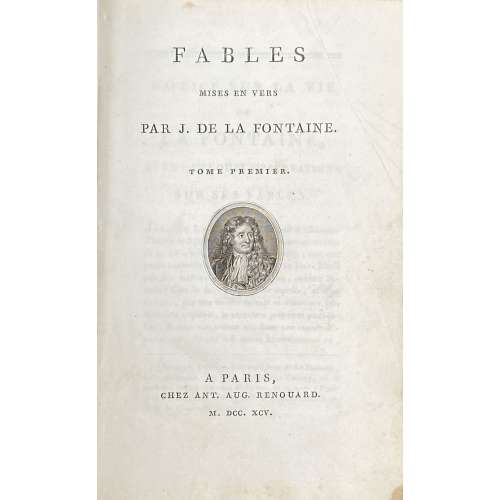 Two 8vo volumes bound in one, 19 x 12.5 cm, in full mottled sheepskin with gilt-bordered boards, gilt decorated flat spine with gilt-lettered red and black calf labels, rebacked, marbled endpapers and edges, printed on wove paper, plates on thicker laid paper. Title-page: FABLES | MISES EN VERS | PAR J. DE LA FONTAINE. | TOME PREMIER (SECOND). | {medallion portrait} (printer’s device “PC”) | A PARIS, | CHEZ ANT. AUG. RENOUARD. | M. DCC. XCV. || Collation: Vol. 1: π2 (h.t./imprint, t.p. medallion portrait/blank), [1]-38 (Notice sur la vie…), 1-58 64 (Vie de la Fontaine, Épitre, Préface, Vie d’Ésope), [7]-148 156 χ3 (table); pagination [4] [i] ii-xlviii, [1] 2-234. Total 143 leaves (286 pages) plus 6 plates after Moreau le Jeune by Devilliers fratres (p. 112), E. De Ghendt (pp. 122 and 181), Jean Louis Delignon (p. 140), Delvaux (p. 197), and Ph. Trière (p. 219). Title medallion portrait of La Fontaine (G Rigault pinx. – C S Gaucher inc.) by Gaucher after Rigaud. Vol. 2: π2 1-158 164; pagination [4] [1] 2-247 [248 blank]. Total 126 leaves (252 pages) plus 6 plates after Moreau le Jeune by Devilliers fratres (p. 19), Villerey (pp. 37, 80, and 146), Bosq (p. 121), and Ph. Trière (p. 199). The book published in 1795 (An 3) supplemented with plates produced in 1811 and 1812 for Œuvres complèttes (sic) de Jean de la Fontaine published by Lefèvre in 1814. The reason for choosing this particular edition for someone's library shortly after 1814 was probably the absence of censorship in 1795. Catalogue raisonné: (1) Lewine [LIB-2538.2020] on p. 276 (Paris, chez Renouard, 1795, 2 vols., 8vo., medal portrait on first title, and 12 plates after Moreau by Delvaux, Bosq, Ghendt, Trière, and Villerey). (2) M.-J.-F. Mahérault. L' oeuvre de Moreau le Jeune : catalogue raisonné et descriptif avec notes iconographiques et bibliographiques. — Paris: A. Labitte, 1880. Contributors: Jean de La Fontaine (French, 1621–1695) – author. Jean-Michel Moreau le Jeune (French, 1741–1814) – artist. Hyacinthe Rigaud (French, 1659 – 1743) – artist. Antoine-Augustin Renouard (French, 1765 – 1853) – publisher. Pierre Causse (French, 1761 – 1834) – printer. Engravers: Charles Étienne Gaucher (French, 1741 – 1804) Etienne De Villiers [Devilliers, Devilliers fratres] (French, 1784 – after 1844) Emmanuel Jean Nepomucène de Ghendt (Flemish, worked in France, 1738 – 1815) Jean-Louis Delignon (French, 1755 – 1820) Rémi Henri Joseph Delvaux (French, 1748 – 1823) Philippe Trière (French, 1756 – c. 1815) Auguste Villerey (French, 1801 – 1846) Jean Bosq (French, fl. c. 1801 – 1844)
Two 8vo volumes bound in one, 19 x 12.5 cm, in full mottled sheepskin with gilt-bordered boards, gilt decorated flat spine with gilt-lettered red and black calf labels, rebacked, marbled endpapers and edges, printed on wove paper, plates on thicker laid paper. Title-page: FABLES | MISES EN VERS | PAR J. DE LA FONTAINE. | TOME PREMIER (SECOND). | {medallion portrait} (printer’s device “PC”) | A PARIS, | CHEZ ANT. AUG. RENOUARD. | M. DCC. XCV. || Collation: Vol. 1: π2 (h.t./imprint, t.p. medallion portrait/blank), [1]-38 (Notice sur la vie…), 1-58 64 (Vie de la Fontaine, Épitre, Préface, Vie d’Ésope), [7]-148 156 χ3 (table); pagination [4] [i] ii-xlviii, [1] 2-234. Total 143 leaves (286 pages) plus 6 plates after Moreau le Jeune by Devilliers fratres (p. 112), E. De Ghendt (pp. 122 and 181), Jean Louis Delignon (p. 140), Delvaux (p. 197), and Ph. Trière (p. 219). Title medallion portrait of La Fontaine (G Rigault pinx. – C S Gaucher inc.) by Gaucher after Rigaud. Vol. 2: π2 1-158 164; pagination [4] [1] 2-247 [248 blank]. Total 126 leaves (252 pages) plus 6 plates after Moreau le Jeune by Devilliers fratres (p. 19), Villerey (pp. 37, 80, and 146), Bosq (p. 121), and Ph. Trière (p. 199). The book published in 1795 (An 3) supplemented with plates produced in 1811 and 1812 for Œuvres complèttes (sic) de Jean de la Fontaine published by Lefèvre in 1814. The reason for choosing this particular edition for someone's library shortly after 1814 was probably the absence of censorship in 1795. Catalogue raisonné: (1) Lewine [LIB-2538.2020] on p. 276 (Paris, chez Renouard, 1795, 2 vols., 8vo., medal portrait on first title, and 12 plates after Moreau by Delvaux, Bosq, Ghendt, Trière, and Villerey). (2) M.-J.-F. Mahérault. L' oeuvre de Moreau le Jeune : catalogue raisonné et descriptif avec notes iconographiques et bibliographiques. — Paris: A. Labitte, 1880. Contributors: Jean de La Fontaine (French, 1621–1695) – author. Jean-Michel Moreau le Jeune (French, 1741–1814) – artist. Hyacinthe Rigaud (French, 1659 – 1743) – artist. Antoine-Augustin Renouard (French, 1765 – 1853) – publisher. Pierre Causse (French, 1761 – 1834) – printer. Engravers: Charles Étienne Gaucher (French, 1741 – 1804) Etienne De Villiers [Devilliers, Devilliers fratres] (French, 1784 – after 1844) Emmanuel Jean Nepomucène de Ghendt (Flemish, worked in France, 1738 – 1815) Jean-Louis Delignon (French, 1755 – 1820) Rémi Henri Joseph Delvaux (French, 1748 – 1823) Philippe Trière (French, 1756 – c. 1815) Auguste Villerey (French, 1801 – 1846) Jean Bosq (French, fl. c. 1801 – 1844) -
![[Hippolyte Prosper Olivier LISSAGARAY]. History of the Commune of 1871 / Translated from the French of Lissagaray by Eleanor Marx Aveling. London: Reeved and Turner, 1886. pp.: [i-v] vi-xv [1] 2-500.](https://varshavskycollection.com/wp-content/uploads/2021/02/LIB-1110.2016-d-500x500.jpeg) Hardcover volume, collated in-8o, 21.9 c 14.6 cm, bound in half red morocco over red buckram by Palmer, Hove & Co. (Manchester), ruled in gilt, marbled end-papers, top edge gilt, spine with raised bands, ruled in gilt, gilt lettering; bookplate "Ex libris William John Robertson" with black ink ms dated 1922 to front pastedown. Insert paper clipping “In Memoriam” marked “D.W. 25.1.61.” Graphite ms to t.p.: “[assisted by Karl Marx]”. Pp.: [i-v] vi-xv [xvi blank], [1] 2-500; collation: ffl blank first and last, π8 A-2H8 2I2. Title-page: HISTORY | OF | THE COMMUNE OF 1871. | Translated from the French of | LISSAGARAY, | BY | ELEANOR MARX AVELING. | LONDON: | REEVES AND TURNER, 196 STRAND. | 1886.|| Contributors: Hippolyte Prosper-Olivier Lissagaray (French, 1838 – 1901) – author. Eleanor Marx [Aveling] (British, 1855 – 1898) – translator. William John Robertson (Canadian, 1846 – 1894) – provenance. The Russian translation of the same title: [LIB-1158.2016] Э. Лиссагарэ. История Парижской Коммуны в 1871 г. (Дешевая библиотека, № 274) / Пер. под ред. В. Базарова. — С.-Петербург: Знание, 1906.
Hardcover volume, collated in-8o, 21.9 c 14.6 cm, bound in half red morocco over red buckram by Palmer, Hove & Co. (Manchester), ruled in gilt, marbled end-papers, top edge gilt, spine with raised bands, ruled in gilt, gilt lettering; bookplate "Ex libris William John Robertson" with black ink ms dated 1922 to front pastedown. Insert paper clipping “In Memoriam” marked “D.W. 25.1.61.” Graphite ms to t.p.: “[assisted by Karl Marx]”. Pp.: [i-v] vi-xv [xvi blank], [1] 2-500; collation: ffl blank first and last, π8 A-2H8 2I2. Title-page: HISTORY | OF | THE COMMUNE OF 1871. | Translated from the French of | LISSAGARAY, | BY | ELEANOR MARX AVELING. | LONDON: | REEVES AND TURNER, 196 STRAND. | 1886.|| Contributors: Hippolyte Prosper-Olivier Lissagaray (French, 1838 – 1901) – author. Eleanor Marx [Aveling] (British, 1855 – 1898) – translator. William John Robertson (Canadian, 1846 – 1894) – provenance. The Russian translation of the same title: [LIB-1158.2016] Э. Лиссагарэ. История Парижской Коммуны в 1871 г. (Дешевая библиотека, № 274) / Пер. под ред. В. Базарова. — С.-Петербург: Знание, 1906. -
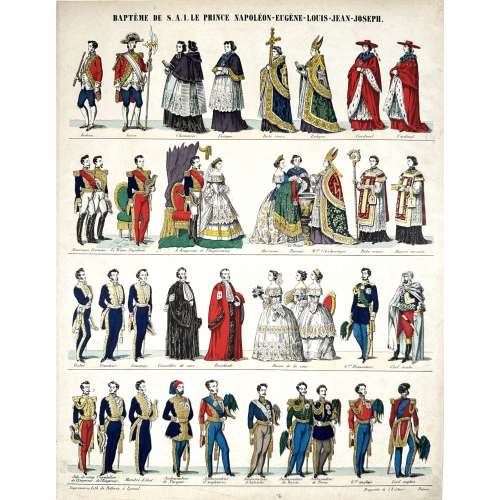 Hand-coloured woodcut on wove paper, 460 x 363 mm; black ink stamp “5054” to reverse. Four tiers with groups of people dressed in uniform, captioned: Bedeau — Suisse — Chanoines — Évêque — Porte croix — Évêque — Cardinal — Cardinal | Généraux français — Le prince Napoléon — L’Empereur et l’Impératrice — Marraine — Le Prince — Parrain | Meur l’Archevêque | Porte crosse Diacre servant | Préfet — Sénateur — Conseiller de cour — Président — Dames de la cour — Gral Piémontais — Chef arabe | Aide-de-camp de l’Empereur — Chambellan de l’Empereur — Ministre d’état — Ambassadeur de Turque | Ambassadeur d’Angleterre — Ambassadeur d’Autriche — Ambassadeur de Russie — Ambassadeur de Prusse — Gral anglaise — Lord anglais || Bottom left: Imprimerie Lith. de Pellerin, à Épinal; right: Propriété de l’Éditeur. — Déposé. Jean Charles Pellerin (French, 1756 – 1836) – printer/publisher.
Hand-coloured woodcut on wove paper, 460 x 363 mm; black ink stamp “5054” to reverse. Four tiers with groups of people dressed in uniform, captioned: Bedeau — Suisse — Chanoines — Évêque — Porte croix — Évêque — Cardinal — Cardinal | Généraux français — Le prince Napoléon — L’Empereur et l’Impératrice — Marraine — Le Prince — Parrain | Meur l’Archevêque | Porte crosse Diacre servant | Préfet — Sénateur — Conseiller de cour — Président — Dames de la cour — Gral Piémontais — Chef arabe | Aide-de-camp de l’Empereur — Chambellan de l’Empereur — Ministre d’état — Ambassadeur de Turque | Ambassadeur d’Angleterre — Ambassadeur d’Autriche — Ambassadeur de Russie — Ambassadeur de Prusse — Gral anglaise — Lord anglais || Bottom left: Imprimerie Lith. de Pellerin, à Épinal; right: Propriété de l’Éditeur. — Déposé. Jean Charles Pellerin (French, 1756 – 1836) – printer/publisher. -
 UTAGAWA TOYOKUNI I (1769–1825) Ichikawa Danjūrō VII (Ebizo V) in a shibaraku costume bursting through a paper screen. Surimono. Colour woodblock print: shikishiban, 8⅛ x 7⅛ in. (20.7 x 18.2 cm) Signed: Toyokuni ga Poem signed: Sakuragawa Jihinari Provenance: Sidney C. Ward
UTAGAWA TOYOKUNI I (1769–1825) Ichikawa Danjūrō VII (Ebizo V) in a shibaraku costume bursting through a paper screen. Surimono. Colour woodblock print: shikishiban, 8⅛ x 7⅛ in. (20.7 x 18.2 cm) Signed: Toyokuni ga Poem signed: Sakuragawa Jihinari Provenance: Sidney C. Ward -
 This print was sold to me with the following description: "Ikkansai EISHO (Fl. early 19th c.). A portrait of the wrestler Kuroyanagi Matsujiro, ring name Kumagatake Inosuke. Eisho was a pupil of Eishi. Published c. 1820s by Uoya Eikichi. Signed Shunsai Eisho ga." As a result of our joint effort with my beloved sister, we have so far found the following: The artis is mentioned in The Hotei Encyclopedia of Japanese Woodblock Prints, 2005, Vol 2; p. 438 under the name of Harukawa Eichō. From this source we learned that the artist was active from about 1818 till 1844, and was a print designer in Kyoto. He was a student first of Harukawa Goshichi and later studied in Edo (Tokyo) with Keisai Eisen, when he assumed the art name 'Eichō'. Other names: Shunsai. The Japanese web page dedicated to Harukawa Eichō provides more details: The artist lived from the 4th year of Tenmei ( 1784 ) to the first year of Kaei ( 1848 ). He was a student of Harukawa Goshichi, Kikukawa Eizan as well as of Keisai Eisen. His popular name was Kamenosuke. He was from Kyoto. He took "gagō" (artistic names) of Eishō when he was a student of Harukawa Goshichi; later, when he became a student of Kikukawa Eizan and Keisai Eisen he took the name of Kikukawa Eichō. The artist was mostly known for his bijinga (beautiful women) prints as well as kanazōshi illustrations. Nothing is said anywhere about his sumo prints, though the reference to another Kyushu sumo wrestler portrait has been found. The sumo wrestler Kuroyanagi Matsujiro is also a somewhat obscure figure: information about his life and career is quite inconsistent. It may so happened that two different persons were combined together. Wikipedia page about Aoi Aso Jinja, a Shinto shrine in Hitoyoshi in Kumamoto prefecture, tells us the following:This information has some inconsistencies already. If our hero was born in 1807 and promoted to ōzeki at the age of 32, it should have been the year 1839, not 1847. I found Kumagatake Isuke at "Sumo Reference" website:
This print was sold to me with the following description: "Ikkansai EISHO (Fl. early 19th c.). A portrait of the wrestler Kuroyanagi Matsujiro, ring name Kumagatake Inosuke. Eisho was a pupil of Eishi. Published c. 1820s by Uoya Eikichi. Signed Shunsai Eisho ga." As a result of our joint effort with my beloved sister, we have so far found the following: The artis is mentioned in The Hotei Encyclopedia of Japanese Woodblock Prints, 2005, Vol 2; p. 438 under the name of Harukawa Eichō. From this source we learned that the artist was active from about 1818 till 1844, and was a print designer in Kyoto. He was a student first of Harukawa Goshichi and later studied in Edo (Tokyo) with Keisai Eisen, when he assumed the art name 'Eichō'. Other names: Shunsai. The Japanese web page dedicated to Harukawa Eichō provides more details: The artist lived from the 4th year of Tenmei ( 1784 ) to the first year of Kaei ( 1848 ). He was a student of Harukawa Goshichi, Kikukawa Eizan as well as of Keisai Eisen. His popular name was Kamenosuke. He was from Kyoto. He took "gagō" (artistic names) of Eishō when he was a student of Harukawa Goshichi; later, when he became a student of Kikukawa Eizan and Keisai Eisen he took the name of Kikukawa Eichō. The artist was mostly known for his bijinga (beautiful women) prints as well as kanazōshi illustrations. Nothing is said anywhere about his sumo prints, though the reference to another Kyushu sumo wrestler portrait has been found. The sumo wrestler Kuroyanagi Matsujiro is also a somewhat obscure figure: information about his life and career is quite inconsistent. It may so happened that two different persons were combined together. Wikipedia page about Aoi Aso Jinja, a Shinto shrine in Hitoyoshi in Kumamoto prefecture, tells us the following:This information has some inconsistencies already. If our hero was born in 1807 and promoted to ōzeki at the age of 32, it should have been the year 1839, not 1847. I found Kumagatake Isuke at "Sumo Reference" website:Kuroki Matsujiro (黒木松次郎) was born in the village of Itsuki in Kuma district, Kumamoto prefecture, island of Kyushu in Bunka era, 4th year (1807). Since from his childhood he was blessed by great physique and tough strength. He had affection for sumo. At the age of 18 he became a sumo student of Kumamoto Shimakawa Ikuhei and took the name of Toyama Hidekichi (遠山日出吉). At the age of 23 (1830), he entered sumo stables in Kyoto, mastered the art of taming of young horses, and his talents improved. At the age of 31 he went to Edo, and became a disciple of the ōzeki Oitekaze Kitaro of Hirado domain in Hizen province, also from Kyushu island. After that, he changed his name and became Kuroyanagi Matsujiro (黒柳松次郎 – as on the print). In 1847 (Bunka era, 4th year) he distinguished himself by advancing to the first grade, and at the age of 32 he was promoted to ozeki level, becoming sekitori. After changing his name to Kuma-ga-take Inosuke (熊ヶ嶽猪之介 / くまがたけいのすけ) he displayed further efforts, and became one of the strongmen that fermented sumo wrestling in Edo. In 1853 (Kaei era, 6th year) he retired and returned to his village, becoming an employee as a strongman of Sagara domain (相良藩), and worked hard as instructor of the sumo training hall to train successors until 1855 (Ansei era, 2nd year) when he passed away at the age of 48. Even today Kuma-ga-take's home exists in Itsukimura (his native village). Also, on those grounds a descendant of Kuma-ga-take runs minshuku (guest house) that bears the name of "The Kuroki Pension (lodging) ", and tourists come to visit from various parts of Japan. In 2015, tenth month, within the borders of Aoi Aso Shrine there was built a gravestone publicly honoring Kuma-ga-take Inosuke, sumo wrestler from Edo / of Edo period.
The real name is the same, the ring name Kuroyanagi Matsujiro is the same, however, the date of birth here is 1815. He fought from 1836 till 1853 - which is quite similar to "At the age of 31 he went to Edo, and became a disciple of the ōzeki Oitekaze Kitaro". Though, in 1836 he might be 29 years old. His bouts are listed from spring 1841 to spring 1848 under the name of Kuroyanagi and from winter 1848 till spring 1853 he listed under the name of Kumagatake Isuke [Inosuke].Highest Rank Maegashira 4 Real Name Kuroki Birth Date 1815 Shusshin Kumamoto-ken, Kuma-gun Death Date March 6, 1855 (40 years) Heya Oitekaze Shikona Kuroyanagi Matsujiro - Kumagatake Isuke Hatsu Dohyo 1836.02 (Sandanme) Intai 1853.02 On another important sumo history website, I found that Kuroyanagi first appeared at ring in the spring of 1823 (he might have been 16 years old then, which does not seem right). Then, in the winter tournament of 1848 Kuroyanagi took the name Kumagatake. At the spring tournament of 1853 Kumagatake (Kuroyanagi) retired. This is quite consistent so far.
Then, I found Oitekaze Kitaro, allegedly the teacher of Kuroyanagi.
Everything look good with an exception of ring names (shikona): Kuroyanagi Matsujiro (1823-1828) - Kuroyanagi Sumiemon (1829-30) - Oitekaze Kitaro (1831-1839). May it be that Sato Matsutaro fought under the name of Kuroyanagi Matsujiro until Kuroki Matsujiro took this name from his master? I don't have another explanation of the enigma. What we know is that we have a portrait of a sumo wrestler called Kuroyanagi Matsujiro from Kyushu, but we don't know whether this was the one from Kumamoto (Kumagatake Inosuke, 1807/1815-1855) or the other from Kanagawa (Oitekaze Kitaro, 1799-1865). Subsequently, we may declare that the artist is Shunsai Eishō, a.k.a.Harukawa Eichō from Eishi school (The Hotei Encyclodepdia, p. 524), we can date the print from 1818 to 1844, and only tell that the wrestler is Kuroyanagi Matsujiro from Kyushu (either Kumagatake Inosuke or Oitekaze Kitaro). The publisher of the print is Moriya Jihei (Marks №353, p. 243-5). That's it.Highest Rank Ozeki Real Name SATO Matsujiro (Matsutaro#) Birth Date 1799 Shusshin Kanagawa-ken, Tsukui-gun Death Date May 4, 1865 (66 years) Heya Oitekaze Shikona Kuroyanagi Matsujiro - Kuroyanagi Sumiemon - Oitekaze Kitaro Hatsu Dohyo 1817.10 (Jonokuchi) Intai 1839.03 -
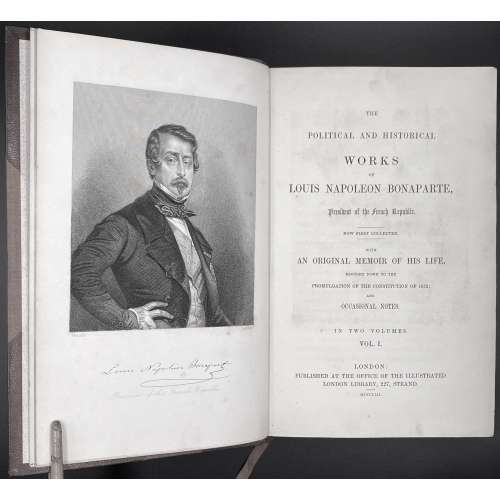 [Bonaparte, Louis Napoleon]. The Political and Historical Works of Louis Napoleon Bonaparte, President of the French Republic, Now First Collected With An Original Memoir of His Life, Brought Down to the Promulgation of the Constitution of 1852; and Occasional Notes, Complete in Two Volumes. London: Illustrated London Library, MDCCCLII [1852]. Collation: Vol. 1: [i-v] vi [vii-viii (blank)] [1] 2-462 [463,464 (blank)]; Vol. 2: [1-3] 4-439 [440]. Size: 22.8 x 14.8 cm (8vo), each. Binding: hardcover; half red morocco and cloth boards, five raised bands, gilt title and decoration, top edge gilt. Frontispiece portrait of Louis Napoleon Bonaparte in Vol. 1. Condition: Very good, rubbing to outer joints, leather corners, faint foxing to endpapers, ownership signature on half-title. Internally bright and unmarked. In binding by Brentano's, New York.
[Bonaparte, Louis Napoleon]. The Political and Historical Works of Louis Napoleon Bonaparte, President of the French Republic, Now First Collected With An Original Memoir of His Life, Brought Down to the Promulgation of the Constitution of 1852; and Occasional Notes, Complete in Two Volumes. London: Illustrated London Library, MDCCCLII [1852]. Collation: Vol. 1: [i-v] vi [vii-viii (blank)] [1] 2-462 [463,464 (blank)]; Vol. 2: [1-3] 4-439 [440]. Size: 22.8 x 14.8 cm (8vo), each. Binding: hardcover; half red morocco and cloth boards, five raised bands, gilt title and decoration, top edge gilt. Frontispiece portrait of Louis Napoleon Bonaparte in Vol. 1. Condition: Very good, rubbing to outer joints, leather corners, faint foxing to endpapers, ownership signature on half-title. Internally bright and unmarked. In binding by Brentano's, New York. -
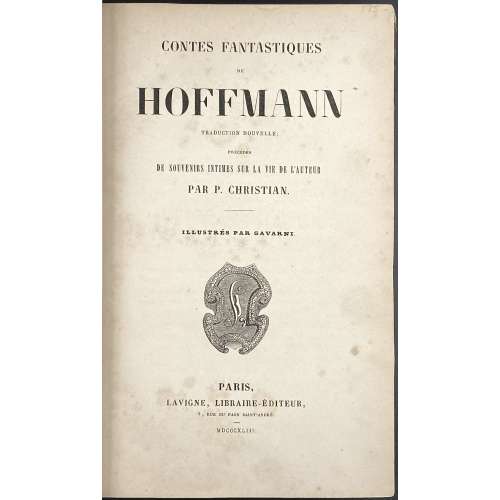 Title: CONTES FANTASTIQUES | DE | HOFFMANN | TRADUCTION NOUVELLE ; PRÉCÉDÉS | DE SOUVENIRS INTIMES SUR LA VIE DE L’AUTEUR | PAR P. CHRISTIAN. | ILLUSTRÉS PAR GAVARNI. | {Publisher’s device} | — PARIS, | LAVIGNE, LIBRAIRE-ÉDITEUR, | 1 RUE DU PAON SAINT-ANDRÉ. | MDCCCXLIII. || Pagination: ffl, [i-vi] –h.t. / colopon, t.p. /blank, dedication /blank, [vii] viii-xix [xx][1,-3] 4-522, bfl, + woodcut illustrations by Brévière et Novionafter Gavarni: 10 full page plates, initials, tail pieces, and in text. Collation: [a]-b4 c2, 1-654 661. Binding: Quarter brown morocco over marbled boards, raised bands with gilt double fillets, gilt arabesque in compartments, title lettering. Catalogue raisonné: L. Carteret (1927), p. 295.
Title: CONTES FANTASTIQUES | DE | HOFFMANN | TRADUCTION NOUVELLE ; PRÉCÉDÉS | DE SOUVENIRS INTIMES SUR LA VIE DE L’AUTEUR | PAR P. CHRISTIAN. | ILLUSTRÉS PAR GAVARNI. | {Publisher’s device} | — PARIS, | LAVIGNE, LIBRAIRE-ÉDITEUR, | 1 RUE DU PAON SAINT-ANDRÉ. | MDCCCXLIII. || Pagination: ffl, [i-vi] –h.t. / colopon, t.p. /blank, dedication /blank, [vii] viii-xix [xx][1,-3] 4-522, bfl, + woodcut illustrations by Brévière et Novionafter Gavarni: 10 full page plates, initials, tail pieces, and in text. Collation: [a]-b4 c2, 1-654 661. Binding: Quarter brown morocco over marbled boards, raised bands with gilt double fillets, gilt arabesque in compartments, title lettering. Catalogue raisonné: L. Carteret (1927), p. 295. -
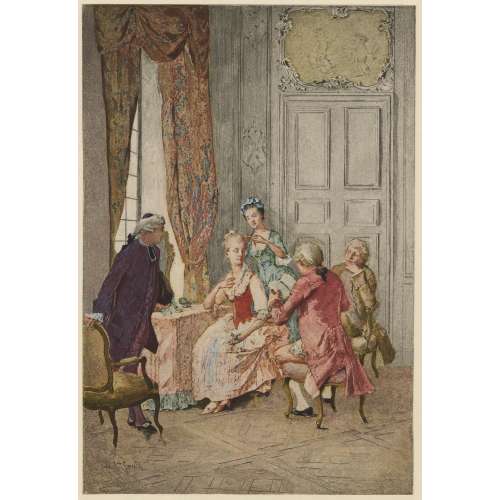
Coloured etching by E. Charreyre (French, fl. 1880 – ?) after a watercolour by Juan Antonio González, (Spanish, 1842 – 1914). A book illustration for 'Son Altesse La Femme' by Octave Uzanne (1851 – 1931), chapter: 'La Caillette' (Le lever d’une petite-maitresse au XVIIIe siècle). Published by Albert Quantin (French, 1850 – 1930) in 1885.
Size: print 17.5 x 12 cm, pasted to leaf 27.7 x 19.5 cm.
-
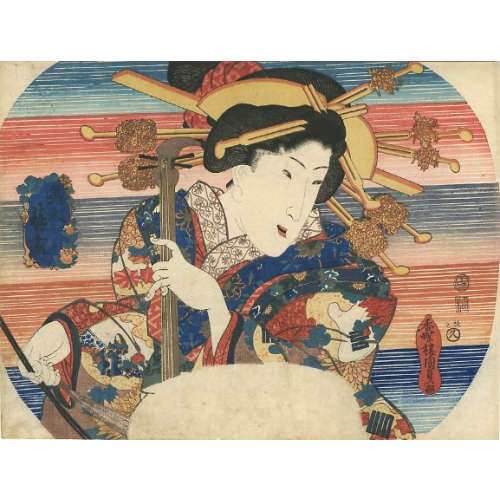 A young woman playing a four-string musical instrument with a bow (kokyū). Series: Assortments of Beauties Accomplishments [美人芸盡] (Bijin gei-zukushi). Utagawa Kunisada [歌川 国貞]; a.k.a. Utagawa Toyokuni III [三代歌川豊国] (Japanese, 1786 – 1865). Signed: Kochoro Kunisada ga [香蝶楼 国貞画] in a red double gourd cartouche. Publisher: Ibaya Kyūbei [伊場屋久兵衛] (Japanese, 1804 – 1851); seal: Hanmoto, Kyū [板元久] (Marks 19-040 | 126e) Date seal: Bunsei 12 (1829). Censors' seal: Kiwame. Size: Fan print (uchiwa-e).
A young woman playing a four-string musical instrument with a bow (kokyū). Series: Assortments of Beauties Accomplishments [美人芸盡] (Bijin gei-zukushi). Utagawa Kunisada [歌川 国貞]; a.k.a. Utagawa Toyokuni III [三代歌川豊国] (Japanese, 1786 – 1865). Signed: Kochoro Kunisada ga [香蝶楼 国貞画] in a red double gourd cartouche. Publisher: Ibaya Kyūbei [伊場屋久兵衛] (Japanese, 1804 – 1851); seal: Hanmoto, Kyū [板元久] (Marks 19-040 | 126e) Date seal: Bunsei 12 (1829). Censors' seal: Kiwame. Size: Fan print (uchiwa-e). -
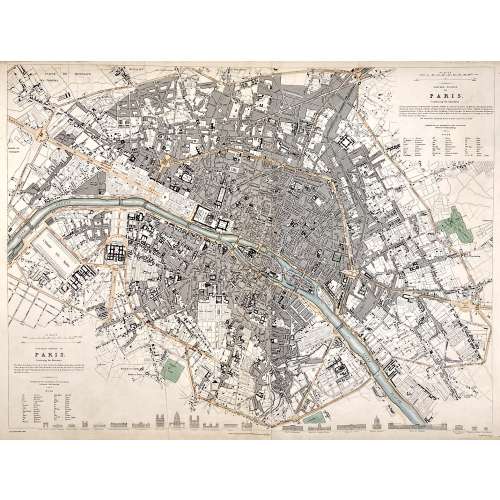 Top right: EASTERN DIVISION OF | PARIS. | Containing the Quartiers | {5 lines in italic} | Published under the Superintendence of the Society for the | Diffusion of Useful Knowledge || Bottom left: WESTERN DIVISION OF | PARIS. | Containing the Quartiers | {4 lines in italic} | Published under the Superintendence of the Society for the | Diffusion of Useful Knowledge || Under the frame: Drawn by W. B. Clarke, Archt. […] London: Published by Chapman and Hall, 186, Strand. April 1st, 1834. [...] Engraved by J. Shury || Dimensions: Sheet: 40.8 x 57 cm; Image: 38.7 x 52.5 cm. Contributors: William Barnard Clarke (British, 1806 – 1865) – artist. John Shury (fl. c. 1814-1844) – engraver. Chapman and Hall (London) – publisher. Society for the Diffusion of Useful Knowledge (SDUK) (British firm, 1826 – 1846).
Top right: EASTERN DIVISION OF | PARIS. | Containing the Quartiers | {5 lines in italic} | Published under the Superintendence of the Society for the | Diffusion of Useful Knowledge || Bottom left: WESTERN DIVISION OF | PARIS. | Containing the Quartiers | {4 lines in italic} | Published under the Superintendence of the Society for the | Diffusion of Useful Knowledge || Under the frame: Drawn by W. B. Clarke, Archt. […] London: Published by Chapman and Hall, 186, Strand. April 1st, 1834. [...] Engraved by J. Shury || Dimensions: Sheet: 40.8 x 57 cm; Image: 38.7 x 52.5 cm. Contributors: William Barnard Clarke (British, 1806 – 1865) – artist. John Shury (fl. c. 1814-1844) – engraver. Chapman and Hall (London) – publisher. Society for the Diffusion of Useful Knowledge (SDUK) (British firm, 1826 – 1846). -
 Superb Edo pictures illustrating dances (Odori keiyô Edo-e no sakae): Interior of an imaginary theatre with a performance of Shibaraku 「踊形容江戸絵栄」. Artist: Utagawa Kunisada [歌川 国貞] a.k.a. Utagawa Toyokuni III [三代歌川豊国] (Japanese, 1786 – 1865). Publisher: Nōshūya Yasubei (Japanese, fl. c. 1851 – 1870). Year: 1858 (Ansei 5), 7th month. Size: Vertical ôban triptych; 36.9 x 75.7 cm. Signed: 一陽斎雛獅豊国筆(年玉印) – Ichiyôsai Hinashi Toyokuni ga (on the left sheet only). Censor's seal: Horse 7 [午七 彫師]. Subject: Shibaraku. Ref.: MFA impression: 11.44263a-c; Robert Schaap. Kunisada (2016), p. 101 [LIB-1212.2017]. Ref.: [LIB-1197.2016] Arendie and Henk Herwig. Heroes of the Kabuki stage: an introduction to Kabuki with retellings of famous plays, illustrated by woodblock prints. — Amsterdam: Hotei Publishing, 2004; p. 38. [LIB-3316.2024] Chris Uhlenbeck, Jim Dwinger, Josephine Smit. The Riddles of Ukiyo-e: Women and Men in Japanese Prints. — Brussels: Ludion, 2023, p. 218-9, № 107.
Superb Edo pictures illustrating dances (Odori keiyô Edo-e no sakae): Interior of an imaginary theatre with a performance of Shibaraku 「踊形容江戸絵栄」. Artist: Utagawa Kunisada [歌川 国貞] a.k.a. Utagawa Toyokuni III [三代歌川豊国] (Japanese, 1786 – 1865). Publisher: Nōshūya Yasubei (Japanese, fl. c. 1851 – 1870). Year: 1858 (Ansei 5), 7th month. Size: Vertical ôban triptych; 36.9 x 75.7 cm. Signed: 一陽斎雛獅豊国筆(年玉印) – Ichiyôsai Hinashi Toyokuni ga (on the left sheet only). Censor's seal: Horse 7 [午七 彫師]. Subject: Shibaraku. Ref.: MFA impression: 11.44263a-c; Robert Schaap. Kunisada (2016), p. 101 [LIB-1212.2017]. Ref.: [LIB-1197.2016] Arendie and Henk Herwig. Heroes of the Kabuki stage: an introduction to Kabuki with retellings of famous plays, illustrated by woodblock prints. — Amsterdam: Hotei Publishing, 2004; p. 38. [LIB-3316.2024] Chris Uhlenbeck, Jim Dwinger, Josephine Smit. The Riddles of Ukiyo-e: Women and Men in Japanese Prints. — Brussels: Ludion, 2023, p. 218-9, № 107. -
 Artist: Utagawa Hiroshige II (二代目 歌川広重] (Japanese, 1826 – 1869). Signed: Hiroshige ga. Publisher: Iseya Sōemon [伊勢屋惣右衛門] (Japanese, c. 1776 – 1862); seal: Hanmoto, Ue [板元 上] (Marks 19-047 | 156d). Combined date seal and kiwame censor seal: Bunkyū 2 (1862) Media: Fan print (uchiwa-e, 団扇絵), 230 x 296 mm.
Artist: Utagawa Hiroshige II (二代目 歌川広重] (Japanese, 1826 – 1869). Signed: Hiroshige ga. Publisher: Iseya Sōemon [伊勢屋惣右衛門] (Japanese, c. 1776 – 1862); seal: Hanmoto, Ue [板元 上] (Marks 19-047 | 156d). Combined date seal and kiwame censor seal: Bunkyū 2 (1862) Media: Fan print (uchiwa-e, 団扇絵), 230 x 296 mm. -
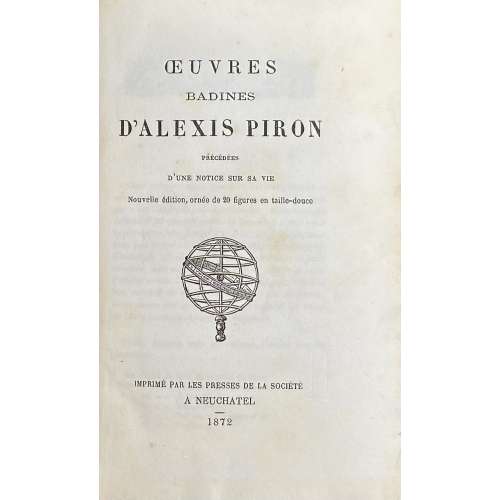 Single volume, 17.1 x 11.2 cm, quarter black sheepskin over faux chagrin, gilt lettering to spine, marbled endpapers, bottom and outer margin untrimmed, pp.: [i-v] vi- xxxvi, [1] 2-218 [2], collated 4to: π2, a-d4, 1-274 282, total 256 pages or 128 leaves, plus 20 engraved plates by Paul Sellier, including frontispiece portrait of Alexis Piron after bust by Caffieri. Vol. 8 of Bibliothèque Libre, Œuvres badines de Piron, printed on February 15, 1872. Text printed on dense wove paper watermarked P or M, plates printed on India wove paper. A reprint of an edition published in 1796 plus illustrations. Title-page: ŒUVRES | BADINES | D’ALEXIS PIRON | PRÉCÉDÉES | D’UNE NOTICE SUR SA VIE | Nouvelle édition, ornée de 20 figures en taille-douce | {vignette} | IMPRIMÉ PAR LES PRESSES DE LA SOCIÉTÉ | A NEUCHATEL | – | 1872 || Limitation: 100 numbered copies, of which this is № 75. Catalogue raisonné: Dutel I: A-788; Pia: 953-6; Kearney 377 (Patrick J. Kearney. A Catalogue of the publications of Jules Gay, Jean-Jules Gay & Gay et Doucé, revised & expanded. — Santa Rosa, CA Scissors & Paste Bibliographies, 2019) Catalogue Poulet-Malassis & ses amis description: № 81. Alexis PIRON. Œuvres badines précédées d’une notice sur sa vie. Nouvelle édition ornée de 20 figures en taille-douce. [ Jules Gay] Imprimé par les presses de la société, à Neufchatel, 1872. In-8, xxxvi, 218 pages et un feuillet d’achevé d’imprimer de table, demi-basane noire, dos à faux nerfs, tête et tranches naturelles. Illustré d’un portrait et de 20 figures par Paul Sellier. Tirage limité à 100 ex. numérotés. De la « Bibliothèque libre ou collection choisie d’ouvrages du genre libre, imprimés ou réimprimés par les soins de la Société des Bibliophiles Cosmopolites et pour les membres de cette société, à cent exemplaires numérotés ». Bibliographie : Pia 1030, Enfer 1274, Lem 3-454, Gay 5-339, PC 353, G* 38, Pey 203, Dutel A-788." Contributors: Alexis Piron (French, 1689 – 1773) – author. Paul Sellier (French, 1842 – 19..?) – artist. Jules Léopold Gay (French, 1807 – 1887) – publisher.
Single volume, 17.1 x 11.2 cm, quarter black sheepskin over faux chagrin, gilt lettering to spine, marbled endpapers, bottom and outer margin untrimmed, pp.: [i-v] vi- xxxvi, [1] 2-218 [2], collated 4to: π2, a-d4, 1-274 282, total 256 pages or 128 leaves, plus 20 engraved plates by Paul Sellier, including frontispiece portrait of Alexis Piron after bust by Caffieri. Vol. 8 of Bibliothèque Libre, Œuvres badines de Piron, printed on February 15, 1872. Text printed on dense wove paper watermarked P or M, plates printed on India wove paper. A reprint of an edition published in 1796 plus illustrations. Title-page: ŒUVRES | BADINES | D’ALEXIS PIRON | PRÉCÉDÉES | D’UNE NOTICE SUR SA VIE | Nouvelle édition, ornée de 20 figures en taille-douce | {vignette} | IMPRIMÉ PAR LES PRESSES DE LA SOCIÉTÉ | A NEUCHATEL | – | 1872 || Limitation: 100 numbered copies, of which this is № 75. Catalogue raisonné: Dutel I: A-788; Pia: 953-6; Kearney 377 (Patrick J. Kearney. A Catalogue of the publications of Jules Gay, Jean-Jules Gay & Gay et Doucé, revised & expanded. — Santa Rosa, CA Scissors & Paste Bibliographies, 2019) Catalogue Poulet-Malassis & ses amis description: № 81. Alexis PIRON. Œuvres badines précédées d’une notice sur sa vie. Nouvelle édition ornée de 20 figures en taille-douce. [ Jules Gay] Imprimé par les presses de la société, à Neufchatel, 1872. In-8, xxxvi, 218 pages et un feuillet d’achevé d’imprimer de table, demi-basane noire, dos à faux nerfs, tête et tranches naturelles. Illustré d’un portrait et de 20 figures par Paul Sellier. Tirage limité à 100 ex. numérotés. De la « Bibliothèque libre ou collection choisie d’ouvrages du genre libre, imprimés ou réimprimés par les soins de la Société des Bibliophiles Cosmopolites et pour les membres de cette société, à cent exemplaires numérotés ». Bibliographie : Pia 1030, Enfer 1274, Lem 3-454, Gay 5-339, PC 353, G* 38, Pey 203, Dutel A-788." Contributors: Alexis Piron (French, 1689 – 1773) – author. Paul Sellier (French, 1842 – 19..?) – artist. Jules Léopold Gay (French, 1807 – 1887) – publisher.


